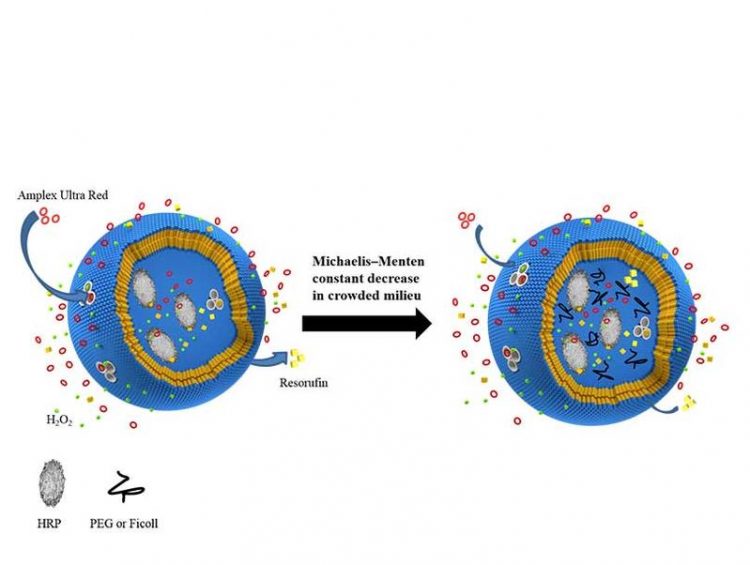Researchers Imitate Molecular Crowding in Cells

Enzymatic reaction inside a nanoreactor, on the left in absence and of a crowding agent and on the right with molecular crowding. University of Basel, Department of Chemistry
The cell interior is densely crowded with hundreds of thousands of macromolecules like proteins, DNA, RNA and smaller molecules forming viscous water solution. In science, this constriction is called “molecular crowding”. The effect can lead to fundamental changes in several of a molecule's characteristics.
The behavior of a “free” protein or enzyme in a test tube does not necessarily follow natural processes, as the cell provides high viscos environment and confined space. In the lab, it had previously only been possible to simulate confined space but not crowded milieu simultaneously.
Imitating mother nature
A team of researchers led by Professor Wolfgang Meier of the University of Basel has now developed a system that comes a significant step closer to the natural model, as for the first time it simulated the crowding effect inside a closed vesicle. “The environment inside a cell has a major effect on the chemical reactions that take place there, so we wanted to copy this in a way coming close to nature as possible,” said Professor Meier.
To create the cellular surroundings, the researchers from the Department of Chemistry made nanoscopic vesicles, so-called polymersomes, and loaded these with the horseradish peroxidase enzyme and a highly viscous solution as crowding components.
The kinetics of chemical reactions by a given enzyme could thus be determined for the first time, taking “molecular crowding” into account.The results show that both factors have a strong influence on enzymatic kinetics.
Controlling the speed of chemical reactions
“Our design takes into account the natural environmental factors that influence enzymes’ performance, and therefore brings us significantly further forward in the development of nanoreactors,” said Professor Meier. The results demonstrate that the behavior of enzymes can be specifically controlled using the crowding effect – an important factor in developing artificial organelles for enzyme replacement therapy.
Original article
Patric Baumann, Mariana Spulber, Ozana Fischer, Anja Car, Wolfgang Meier
Investigation of horseradish peroxidase kinetics in an ‘organelle like’ environment
Small (2017), doi: 10.1002/smll.201603943
Further information
Prof. Dr. Wolfgang P. Meier, University of Basel, Department of Chemistry, Tel. +41 61 207 38 02, Email: Wolfgang.Meier@unibas.ch
Media Contact
More Information:
http://www.unibas.chAll latest news from the category: Life Sciences and Chemistry
Articles and reports from the Life Sciences and chemistry area deal with applied and basic research into modern biology, chemistry and human medicine.
Valuable information can be found on a range of life sciences fields including bacteriology, biochemistry, bionics, bioinformatics, biophysics, biotechnology, genetics, geobotany, human biology, marine biology, microbiology, molecular biology, cellular biology, zoology, bioinorganic chemistry, microchemistry and environmental chemistry.
Newest articles

Webb captures top of iconic horsehead nebula in unprecedented detail
NASA’s James Webb Space Telescope has captured the sharpest infrared images to date of a zoomed-in portion of one of the most distinctive objects in our skies, the Horsehead Nebula….

Cost-effective, high-capacity, and cyclable lithium-ion battery cathodes
Charge-recharge cycling of lithium-superrich iron oxide, a cost-effective and high-capacity cathode for new-generation lithium-ion batteries, can be greatly improved by doping with readily available mineral elements. The energy capacity and…

Novel genetic plant regeneration approach
…without the application of phytohormones. Researchers develop a novel plant regeneration approach by modulating the expression of genes that control plant cell differentiation. For ages now, plants have been the…





















